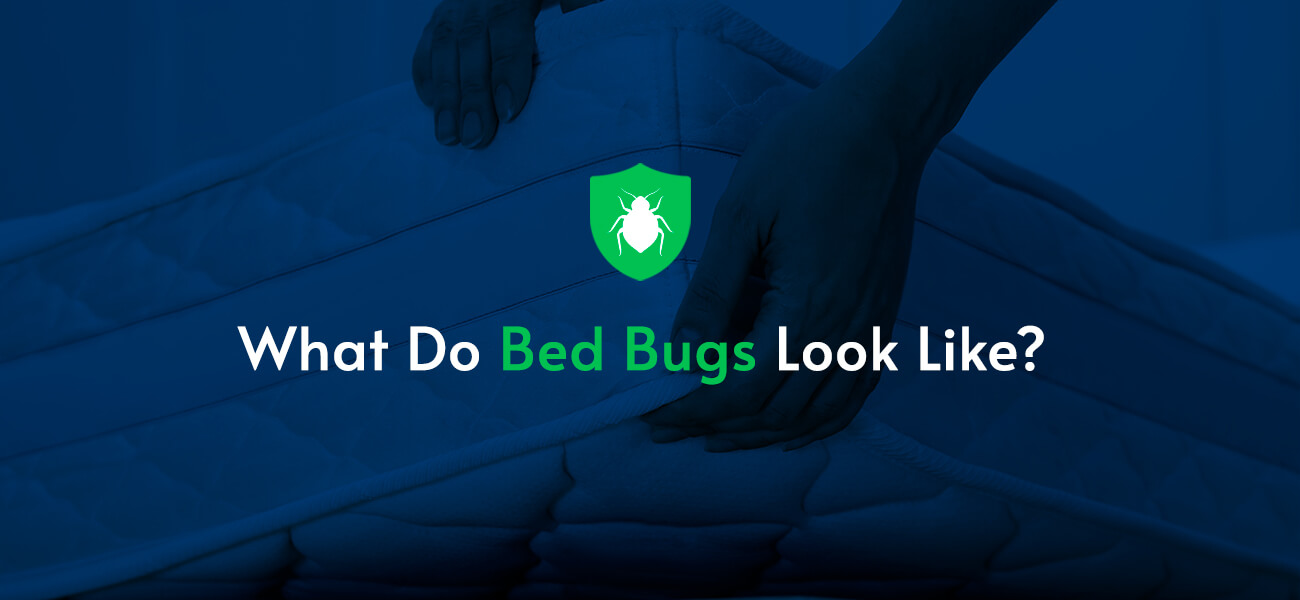What Do Bed Bugs Look Like?

Could anything be worse than having tiny bugs crawl over you and bite you in the night? Unfortunately, statistics indicate that one in five Americans has either experienced bed bugs themselves or knows someone who has. Bed bugs are a very common problem.
Since they’re so prevalent, it’s important that you have the tools you need to recognize them. The sooner you reach out for professional help, the faster and easier it will be to get bed bugs out of your home and business. Here’s everything you need to know about identifying bed bugs.
Identifying Bed Bugs 101
The first step for how to tell if you have bed bugs is to know what they look like. Because they are small and can hide so well, bed bugs can be difficult to find. However, you should have no trouble finding bugs or evidence of bugs if you have a heavy infestation.
What Do Bed Bugs Look Like?
Fully grown bed bugs appear a reddish-brown color and may look striped. They can be flat or round, depending on how recently they’ve eaten. As adults, bed bugs are about the size of an apple seed. More technically, an adult bed bug usually measures 5-7 millimeters or 3/16-1/4 inches long.

Another way to identify bed bugs is by the musty smell they emit from glands on their bodies. Unlike many other small insects, bed bugs don’t fly, hop or jump — they crawl to get around. Bed bugs also have antennae that they use to find food.
Recognizing Bed Bugs in Different Stages
Bed bugs have several life stages, and they can look different depending on what stage you find them in. If you have a bad infestation, you’ll likely find bed bugs in all stages of their life cycle at the same time.
Bed bug eggs are very small, about the size of a pinhead or measuring about 1 millimeter across. They’re a white color and may have a small spot on them later in development. When a female bed bug is mature, they can lay 1-5 eggs every day. Eggs hatch after two weeks.
During the next stage of their life, bed bugs are called nymphs. These adolescent bed bugs are a lighter color than adults, sometimes appearing almost see-through. After eating, they become darker just like adult bed bugs. Nymphs become full-grown adults and can reproduce in about five weeks.
Common Mistakes in Bed Bug Identification
It can be easy to mistake another bug as a bed bug and then worry you have an infestation. Thankfully, bed bugs are physically very different from other bugs. If you know what to look for, they’re easy to recognize.
Other Bugs Mistaken for Bed Bugs
Several types of insects have a similar shape, size or color to bed bugs. Because bed bugs can be so small, it can sometimes be tricky to tell these bugs apart at first glance. Here are eight bugs that are commonly mistaken for bed bugs:
- Carpet beetles
- Ticks
- Fleas
- Head lice
- Bat bugs
- Small cockroaches
- Spider beetles
- Booklice
Each of these bugs has similarities to bed bugs, but on closer inspection, they have different shapes, leave different evidence behind and prefer different environments. By taking the full context of these insects into account, you can determine whether or not you have bed bugs.
For example, booklice like to live in magazines, wooden furniture, and — you guessed it — books. They have a round head that looks very different from bed bugs and move in a fast, darting run.
How to Find Bed Bugs
Because they’re good at staying concealed, you might not be able to find and physically examine a bed bug. However, bed bugs will leave several signs behind that can help you determine whether or not you have an infestation.
Initial Signs of Bed Bugs
Most people start worrying about bed bugs because they find bites on their skin. While not everyone reacts to bites, most people will have a raised, itchy red bump after being bitten. Because of the way they eat, bed bugs also tend to bite several times in a linear or zigzag pattern.
If you’re consistently getting bug bites at night, you should consider looking for other signs of bed bugs. Because not everyone reacts to bites, you may notice red spots and your partner may not. It’s very possible that you have bed bugs even if your partner doesn’t notice any change at night.
Where Do You Check for Bed Bugs?
If you’re getting bitten and suspect it’s bed bugs, there are several key places you should check. Start by taking the bedding off your mattress so you can look for eggs, dark spots and molted insect husks. If you have a bad infestation, you may even find nymphs and adults along the seams of your mattress.
They may also be hiding in your headboard, box spring and nearby bedroom furniture. Their ideal environment is anywhere they can hide and still be close to you — their food source. This means they could also be in other furniture like couches, upholstered chairs and carpet.
Bed Bugs in Clothing
In addition to furniture, bed bugs may also hide in clothing. You can check your closet for bed bugs by taking everything out and examining cracks in the floors, dressers and corners. Running your clothes through a hot washer and dryer cycle will kill any bugs and eggs on them.
However, that won’t necessarily take care of the problem if they’re also living in cracks in your closet. As their numbers grow, bed bugs are happy to spread throughout your house — which means you should get help as soon as you know you have a problem.
Causes and Prevention of Bed Bug Infestations
The best way to get rid of bed bugs is to prevent them from ever entering your home or business. Once they’re inside, it can be challenging to get rid of them. Thankfully, there are several practical things you can do to prevent bed bug infestations.
Main Causes of Bed Bugs
Often, people bring bed bugs home after traveling and staying in hotels. If one traveler has bed bugs on their clothes and luggage, they can spread them to others. Bed bugs can also spread quickly through apartment buildings or come into your home on used furniture.
Once an infestation starts, it can take a while for people to realize what’s going on. This gives bed bugs an opportunity to spread to visitors, guests and travelers, who may unknowingly continue to spread the problem.
Bed Bug Prevention
One of the best ways to prevent bed bugs is to check for them before you unpack at hotels. Pull the sheets off a corner of your mattress and check for any sign of these insects, including dark spots. You can also keep your suitcase and other belongings off the floor and bed.
When you get home from a trip, wash all your clothes in hot water to kill any possible hitchhikers. You can also put a cover on your box spring and mattress to reduce hiding spots. If you live in a shared apartment, consider filling cracks in the walls and under any doors to discourage insect visitors.
Get Professional Help for Bed Bugs From Pestech Pest Solutions
If you think you have bed bugs, don’t wait to get help. Acting quickly is the number one way to get a handle on a bed bug infestation — the longer you wait, the more difficult it may be to get rid of them because they’ll continue to reproduce and spread.
Pestech Pest Solutions offers pest control services across New York’s Hudson Valley. We’re a family-owned, local business that’s been helping residents and commercial businesses with pest control since 1989. Contact us today to find out how we can help with bed bugs!

